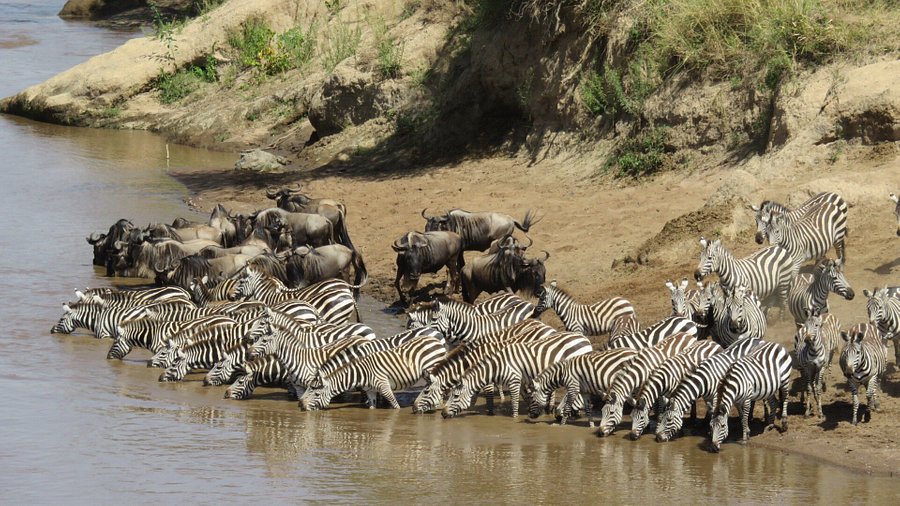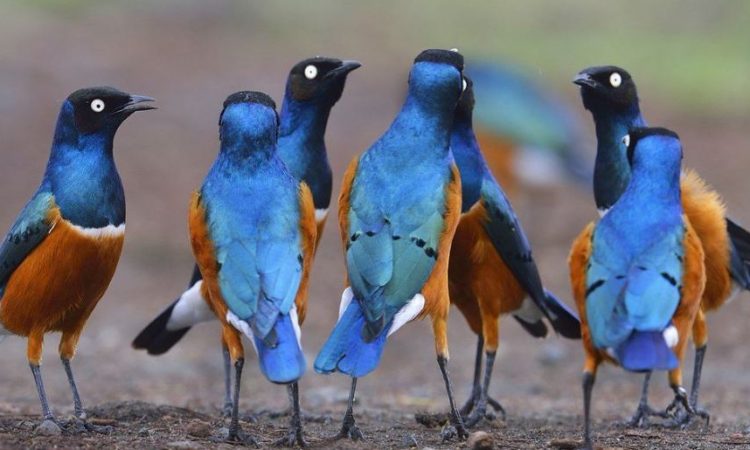Masai Mara national reserve is One of Africa’s most well-known safari park, the Maasai mara national reserve wildlife watching is excellent all year-round. A large population of herbivores is supported by the grassy plains and regular rains, which in turn draw many predators. The three big cats (Lions, Leopards, and Cheetah) are all quite simple to spot in this park. The park also host one of the most incredible animal shows in the entire world-the annual wildebeest migration that migrates from Tanzania’s Serengeti national park through two challenging rivers of Grumeti and mara river to maasai mara national reserve.

WILDLIFE IN MAASAI MARA NATIONAL RESERVE
The Maasai mara national reserve is the number one safari park in Kenya and one of the best national park in Africa hosting and supporting a larger numbers of animals, birds etc. Four of the Big Five are almost certainly to be seen in this park. Although more elusive, black rhinos are occasionally seen in the Mara Triangle. Although sightings of lesser predators like spotted hyenas, black-backed jackals, and bat-eared foxes are often frequent, the reserve is one of the best for large cats. Impala, reedbuck, Thomson’s gazelle, eland, and topi are some of the antelopes that can be seen in Maasai mara national reserve. Other animals in Maasai mara includes buffalo, elephant, and giraffe, wildebeest, zebras, and many more.

ANIMAL HIGHLIGHTS IN MAASAI MARA NATIONAL RESERVE
One of the most incredible wildlife encounters in the world is the fabled wildebeest migration that can be seen in Two East Africa Countries of Kenya in Maasai mara national reserve and Tanzania in Serengeti national park. Millions of animals migrate out of the Serengeti between July and August, arriving in the Masai Mara in September. The most breathtaking aspect of the migration is when the animals cross the Mara River. After arriving to Maasai mara national reserve, the migratory herds slowly makes its way back into the Serengeti around November. Although the pattern is widely understood, it should be emphasized that the precise timing of the migration is uncertain as animals travel with the rain in search of greener pastures.
THE BEST TIME FOR ANIMAL VIEWING IN MAASAI MARA NATIONAL RESERVE
The Masai Mara offers good year-round wildlife watching. The Great wildebeest migration is at its best in September and October. Generally speaking, June to October are the driest months and best time for wildlife watching safaris.
SCENERY IN MAASAI MARA NATIONAL RESERVE
While grassland savannah predominates in the Masai Mara’s landscape, pockets of acacia woodland, riparian forest, and rocky hills are dotted throughout the plains. These specks on the landscape are referred to by the Masai word “Mara,” which means speckled.
WEATHER AND CLIMATE IN MAASAI MARA NATIONAL RESERVE
The climate in the Masai Mara is often warm and stays close to a pleasant 25°C (77°F) during the dry season (June to October). The park’s elevation differences are mostly to blame for temperature variations, with conditions becoming colder as you ascend. The rainy season, which runs from November to May, is divided into two longer and shorter wet periods.
From June to September is the dry season.
With the pleasant weather, it’s a pleasure to spend time in the park during these months. The weather is often sunny and rarely unbearably hot. When planning your Tanzania safari tour to Maasai Mara National Reserve during this time, winter clothes should be packed for early-morning game drives.
It can still rain in June, July, and August, but the weather is typically sunny and dry. Although the cold might linger in the evenings and early mornings when temperatures of around 12 °C (54 °F) are typical, afternoon temperatures reach a pleasant 25 °C (77 °F).
Even though rain is a possibility on some days, September and October are the driest months of the year. In October, temperatures rise slightly and average around 27°C (81°F) (or higher) before dropping as rain starts to fall. Early mornings continue to be chilly (about 12°C/54°F).
From November to May is the rainy season
During these months, there are a lot of cloudy, overcast days. Showers in the afternoon are typical. The daily temperature range is not very wide. Temperatures in the chilly early mornings are around 13°C (55°F). When planning your safari tour to Maasai Mara National Reserve during these months we advise you to pack some warm clothing.
“Short rains” in November and December: By the end of November, the rains usually stop. Around 27°C/81°F is what the afternoon temperature usually is. Between the short and lengthy rains, rainfall lessens in January and February, while showers still happen. It can be difficult to forecast when this dry season will start.
“Long rains” occur in March, April, and May; April is the wettest month. Although it doesn’t frequently rain all day, it does occasionally. Tracks may become slick and challenging to navigate. Average temperatures in the early mornings are around 13°C (55°F).
THE BEST SEASON TO VISIT MAASAI MARA NATIONAL RESERVE
Masai Mara is best visited between the short and long rainy seasons (January and February) and the dry season (June to October). During this time, Rain hasn’t yet caused the roads to deteriorate, and thirsty animals congregate around the nearby streams. The breathtaking yearly migration of the wildebeest frequently passes through during the final two months of the dry season.

THE MIGRATION OF THE WILDEBEEST IN MAASAI MARA NATIONAL RESERVE
The annual wildebeest migration, which involves 2.5 million wildebeest, zebra, and gazelles migrating in search of new pasture, takes place in the Serengeti-Mara habitat. In July and August, they travel from the Serengeti to the Masai Mara, where they often arrive in September. One of the attractions of this amazing event is the crossing of the Mara River along the journey. They return to Tanzania’s Serengeti national park around the end of October.
TOURIST ACTIVITIES: THINGS TO DO IN MAASAI MARA NATIONAL RESERVE
The Masai mara national reserve is the beautiful safari park in Africa with a lot of attractions and activities for visitors to enjoy their safari holiday in this number one Kenyan safari park. The park has everything for everyone to do from solo travelers, family, children, couples and honeymooners. Some of the things to do in Maasai Mara national Reserve are as follows;
Hot air balloon safaris
The most amazing way to view this amazing ecosystem is probably from a hot air balloon over the Masai Mara. View the region more clearly and take in the Masai Mara’s beauty from above. Just before dawn, the hot air balloon takes off from the Little Governors’ Camp, rising as the first rays of sunlight illuminate the Mara.
As you soar over the plains in a balloon and observe the wildlife below, take in the calm of the experience. You will float in the breeze and get a totally unique view of the Masai Mara’s vegetation and rivers. See why the Masai called this the “Mara,” which means “spotted,” as you take in the tree circles, cloud shadows, and scrubland that make up the stunning landscape.
In your Hot Air Balloon Safari in Maasai Mara National reserve, you will fly for almost an hour, seeing some amazing vistas and having plenty of time for photos and videos. On many excursions, you will be welcomed with a champagne breakfast that is prepared where you land, keeping with the custom of hot air balloon rides.
Game drives
Game drives take you outside and within the Masai Mara to look for the famous animals. Enjoy game drives in 4x4s that have been specially developed for this environment for amazing game viewing. You will be accompanied by an experienced and knowledgeable safari guide who will be giving you interesting facts of whatever you came across during your game drive safari.
All of the Big 5 animals, including lions, elephants, cape buffaloes, and rhinoceroses, as well as giraffes, hippos, hyenas, Nile crocodiles, wildebeest, zebra, gazelles, antelopes, and more, can be seen in your Masai mara national reserve safari during game drive.
See the migration of the wildebeest.
Over a million wildebeest, zebra, and gazelles move from Tanzania to Kenya’s Masai Mara every year in a continuous cycle in response to the rains and new grass. Predators in the Masai Mara, as well as hundreds of tourists, look forward to the migration, which frequently occurs between the months of July and October.
Take pleasure in Masai Cultural Visits.
The Masai have been residing on the Mara for a few hundred years and continue to practice their ancient customs and traditions, albeit with some modern influences. You can go to a Masai hamlet, such as Mara Rianda, while in the Masai Mara. This is a Masai livestock region surrounded by a hamlet of 48 traditional homes. If you want to learn more about the Masai culture and take part in long-standing rituals and practices, this is an excellent location to go to.
Birdwatching
With over 470 species to discover, the Masai Mara national reserve is a fantastic location for birdwatching. Although people tend to focus on large creatures, there are still some fascinating birds to be seen. Ostriches, the largest bird in the world, small sunbirds, and 46 species of raptors are just a few examples of the bird spices never miss to look for when you’re in Maasai Mara National Reserve. The ground hornbills, which are about the size of a turkey, as well as secretary birds, plovers, and white stalks, are hidden by the grass. As a result, the swampy areas are excellent locations to see a variety of storks and cranes, including saddle-billed storks looking for catfish.
The largest heron in the world, the goliath, as well as sacred ibis, yellow-billed storks, and great white egrets, can all be seen. There are seven species of enormous kingfisher, among many other kingfisher varieties. These are typically visible on the Mara River itself. Visitors are frequently astounded by the sheer number of these birds to see, and the vultures are easy to spot because they focus on lion kills.

Walking safaris
Walking safaris is an excellent way of exploring the Maasai mara ecosystem in a more natural way and up close. Experience the area on foot with knowledgeable guides. Enjoy more excitement as you explore the Masai Mara in search of some amazing wildlife now that you are not inside a specially designed safari vehicle. The Focus East Africa Tour Company also offers walking safaris, and after your stroll you’ll be treated to a full cooked champagne bush breakfast.
Check out the Mara River.
Because of the yearly wildebeest migration, the Mara River is among the most well-known tourist attraction in the world of documentaries. The river rises in the highlands of Kenya and empties into Lake Victoria, the biggest tropical lake in the world. Animals around the Mara River depend heavily on this water source, which doubles in size during periods of intense precipitation. The river is located in the center of the Masai Mara National Reserve, where you may see a variety of birds, hippos, and crocodiles.


